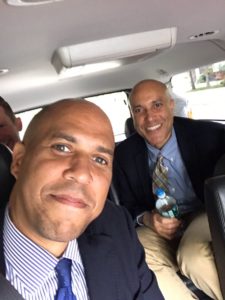The highly-regarded Brookings Institute has a new study out today which grades 13 cities on the “critical role of school choice.” NJ’s cities aren’t on the list, though there’s no shortage of Garden State passion on the issue.
This week, in fact, NJ hosts two dueling rallies on issues of school choice. The first, this afternoon in Jersey City, is sponsored by a bevy of opponents to the Opportunity Scholarship Act, which would give corporate-funded scholarships to poor kids in cities with rotten schools. (The original version of the bill included 13 cities. Now there’s only 3-5 cities on the list, depending upon whom you ask.)
Participants in the anti-choice rally include Save Our Schools-NJ (the no-charters-in-rich-suburbs organization), Gordon MacInnes (former “Abbott Czar” at the DOE and chief cook and bottle washer for the NJ poverty-is-destiny groupies), and the Coalition for Effective Newark Public Schools (whose members include the Newark Teachers Union and Education Law Center).
The second rally, in support of OSA, is tomorrow morning in Trenton and is sponsored by Excellent Education for Everyone (E3). There’s no list of sponsors available.
Anyway, back to Brookings. According to the report, a quarter of parents of school age children among the cities studied “report that they moved to their current neighborhood for the school. Another 11 percent of families choose to pay for their children to attend private schools.” In fact,
more than 50 percent of parents of school-aged children have engaged in some form of school choice, albeit primarily in the form of residential choice and private school tuition: two socially inequitable means of determining where a child attends school. There is little doubt based on the long waiting lists for popular public schools of choice that many more parents wish to exercise choice than are currently able to do so, and schools of choice consistently generate more positive evaluations from parents than assigned schools.
So part of Brookings’ rubric for assessing socially equitable school choice measures whether students are assigned schools based on parent preferences and not on zip code. Conversely, the study measures whether “assignment to schools out of the students’ geographical attendance zone is difficult, unclear, or substantially disadvantages parents.”
In NJ, of course, students are assigned schools based on zip code which, according to Brookings, is a “socially inequitable means of determining where a child attends school.” Well-to-do families exercise school choice all the time by moving to better districts or paying private school tuition, poor families are trapped by district boundaries. The only way out is our embattled charter school environment or through the Interdistrict Public School Choice program, which serves a few thousand kids.
Take Trenton residents for an example. While there are four charter schools in the area serving about 1,000 kids, everyone else goes to the Trenton Public Schools. At Trenton Central High School 71.5% of students failed the 2010 HSPA, the 8th grade-level assessment given to juniors. 39% failed the HSPA in language arts. If families could afford to move to, say, Princeton (hey – it’s only 10 miles down Rte. 206, not to mention the birthplace of Save Our Schools-NJ), their kids would be educated in an environment where only 11% of kids failed the math portion of the 2010 HSPA and a mere 5% failed language arts.
The problem is that you have to have money to move. Any system that bases school attendance on zip code is socially inequitable. New Jersey, according to Brookings’ rubric, gets a big fat F in school choice. From the report:
Our framework places considerable emphasis on the processes by which students are assigned to schools, treating it as a major category for evaluating choice and competition. The antithesis of choice is an assignment mechanism based on residence, with little or no chance of parents being able to enroll their child in a school other than the one in their neighborhood.



